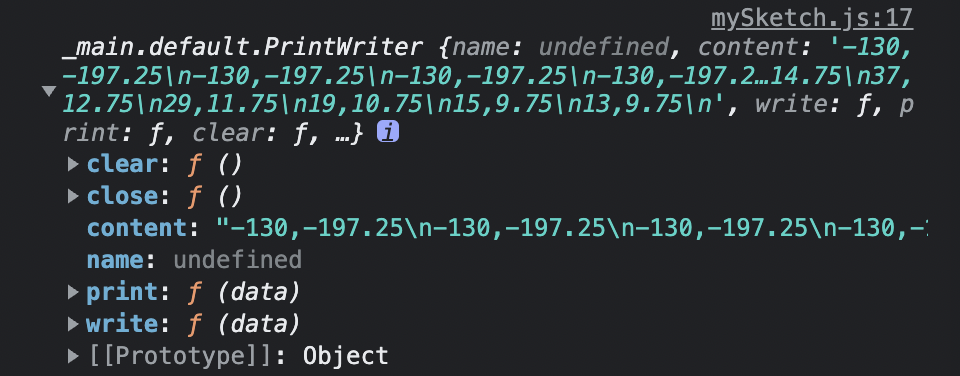今天來整理有關資料記錄與儲存的操作
在網頁中有時需要記錄操作的資訊,民眾的輸入,查詢的資料等等,
在p5.js中有提供一些有關儲存等功能,
save(),saveJSON(),saveStrings(),saveTable()
但是這些指令會引發儲存的對話框,主要是要讓使用者將資料存在使用者的電腦中。
現在的需求是要在背景中儲存檔案,一般有2種方式,
一種是利用session或是cookie,另一種是利用PHP儲存檔案。
先來看看PHP的方法
p5.js提供一個記錄的功能 createWriter()
writer.print(mouseX+","+mouseY); //-- 將滑鼠座標存到writer中,並且是一筆一筆儲存
查看writer中的內容 writer.content
建立的物件是 PrintWriter

JS
let writer;
let fname;
function setup() {
writer = createWriter();
fname = "word3.txt";
}
function draw(){
if(mouseIsPressed){
writer.print(mouseX+","+mouseY); //-- 將滑鼠座標寫入writer中
}
}
function keyPressed(){
console.log(writer);
console.log(writer.content);
saveTxt(writer.content.trim()); //-- 將資料傳送到PHP網頁
}
function saveTxt(txt){
let url = "upload_txt.php";
const xhttp = new XMLHttpRequest();
xhttp.onload = function() {
console.log(this.responseText);
console.log(this.getAllResponseHeaders());
}
xhttp.open("POST", url);
xhttp.setRequestHeader("Content-type", "application/x-www-form-urlencoded");
xhttp.send("fname="+fname+"&wordx="+txt);
}
writer = createWriter(); 建立writer物件
writer.print(mouseX+","+mouseY); 將資料寫入writer
writer.content.trim() 讀取writer中的內容,並去除多餘的空白字元
使用 XMLHttpRequest() 將資料上傳到 upload_txt.php
PHP (upload_txt.php)
<?php
$wordx = $_POST["wordx"];
$fname = $_POST["fname"];
echo "from php: " . $wordx . "\n";
if(strlen($wordx)>0){
if(!file_exists($fname) || filesize($fname)==0){
//-- 如果檔案不存在或是檔案大小為0,則直接寫入檔案
$myfile = fopen($fname, "w") or die("Unable to open file!");
fwrite($myfile, $wordx);
fclose($myfile);
} else {
//-- 如果檔案已存在,則先將檔案讀出,加上新上傳的資料,再寫入檔案
$myfile = fopen($fname, "r") or die("Unable to open file!");
$txt = fread($myfile, filesize($fname));
$txt = $txt . "\n" . $wordx;
fclose($myfile);
$myfile = fopen($fname, "w") or die("Unable to open file!");
fwrite($myfile, $txt);
fclose($myfile);
//echo $txt;
}
}
?>
利用之前文章的範例,將網路讀取的資料儲存成csv檔
JS
let writer;
let fname;
function setup() {
writer = createWriter();
fname = "park_place.csv";
let url = "https://tcgbusfs.blob.core.windows.net/blobtcmsv/TCMSV_alldesc.json";
const xhttp = new XMLHttpRequest();
xhttp.onload = function() {
console.log(this);
const json_obj = JSON.parse(this.responseText);
console.log(json_obj.data.park);
console.log(this.getAllResponseHeaders());
let data1 = json_obj.data.park.filter( (x, i) => i<50 );
console.log(data1);
for(let x of data1){
writer.print(x.id+","+x.area+","+x.name);
}
}
xhttp.open("GET", url, true);
xhttp.send();
}
function keyPressed(){
console.log(writer);
console.log(writer.content);
saveTxt(writer.content.trim());
}
function saveTxt(txt){
let url = "upload_csv.php";
const xhttp = new XMLHttpRequest();
xhttp.onload = function() {
console.log(this.responseText);
console.log(this.getAllResponseHeaders());
}
xhttp.open("POST", url);
xhttp.setRequestHeader("Content-type", "application/x-www-form-urlencoded");
xhttp.send("fname="+fname+"&wordx="+txt+"&start=\uFEFF");
}
其中
json_obj.data.park.filter( (x, i) => i<50 ); //-- 挑選前50筆資料
在傳送資料中多傳送了一個特別的字元 '\uFEFF'
xhttp.send("fname="+fname+"&wordx="+txt+"&start=\uFEFF");
主要是在儲存成csv檔時,若用Excel開啟時,會產生亂碼的狀況,
因此若在檔案開頭加上 '\uFEFF' 就不會有亂碼了。
不過只要在檔案開頭加一次就好了,
因此,特別分開上傳這個字元,要交由PHP判斷如果是新建立檔案,再在檔案開頭加上 '\uFEFF'
PHP (upload_csv.php)
<?php
$wordx = $_POST["wordx"];
$fname = $_POST["fname"];
$start = $_POST["start"]; //-- 當作csv檔案開頭字元
echo "from php: " . $wordx . "\n";
if(strlen($wordx)>0){
if(!file_exists($fname) || filesize($fname)==0){
$myfile = fopen($fname, "w") or die("Unable to open file!");
$wordx = $start.$wordx; //-- 如果是新建立檔案,就在檔案開頭加上 '\uFEFF'
fwrite($myfile, $wordx);
fclose($myfile);
} else {
$myfile = fopen($fname, "a") or die("Unable to open file!");
fwrite($myfile, "\n".$wordx);
fclose($myfile);
}
}
?>
其中
fopen($fname, "a") : "a"的參數是指直接加在檔案的結尾,不過加入前要先加上一個換行符號 "\n"
fopen($fname, "r") : "r"的參數是指讀取檔案內容
fopen($fname, "w") : "w"的參數是指重新寫入檔案中,因此如果原本檔案有資料的話會被清除掉
JS
let writer;
let fname;
function setup() {
writer = createWriter();
fname = "park_place.json";
let url = "https://tcgbusfs.blob.core.windows.net/blobtcmsv/TCMSV_alldesc.json";
const xhttp = new XMLHttpRequest();
xhttp.onload = function() {
console.log(this);
const json_obj = JSON.parse(this.responseText);
console.log(json_obj.data.park);
console.log(this.getAllResponseHeaders());
let data1 = json_obj.data.park.filter( (x, i) => i<30 );
writer.print(JSON.stringify(data1));
}
xhttp.open("GET", url, true);
xhttp.send();
}
function keyPressed(){
console.log(writer);
console.log(writer.content);
saveTxt(writer.content.trim());
}
function saveTxt(txt){
let url = "upload_json.php";
const xhttp = new XMLHttpRequest();
xhttp.onload = function() {
console.log(this.responseText);
console.log(this.getAllResponseHeaders());
}
xhttp.open("POST", url);
xhttp.setRequestHeader("Content-type", "application/x-www-form-urlencoded");
xhttp.send("fname="+fname+"&wordx="+txt+"&start=\uFEFF");
}
其中
let data1 = json_obj.data.park.filter( (x, i) => i<30 );
writer.print(JSON.stringify(data1)); //-- 將json物件或陣列「字串化」再上傳到PHP
PHP (upload_json.php)
<?php
$wordx = $_POST["wordx"];
$fname = $_POST["fname"];
echo "from php: " . $wordx . "\n";
if(strlen($wordx)>0){
$myfile = fopen($fname, "w") or die("Unable to open file!");
fwrite($myfile, $wordx);
fclose($myfile);
}
?>
參考資料
PHP Filesystem Functions
https://www.w3schools.com/php/php_ref_filesystem.asp
fopen
https://www.php.net/manual/zh/function.fopen
